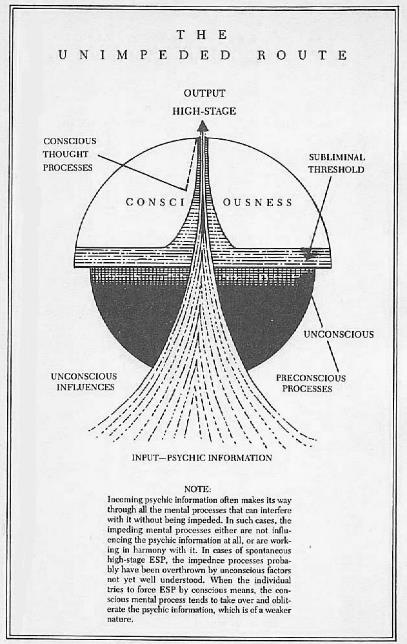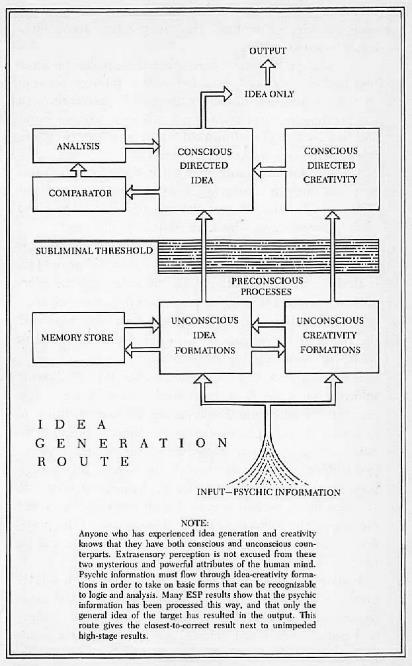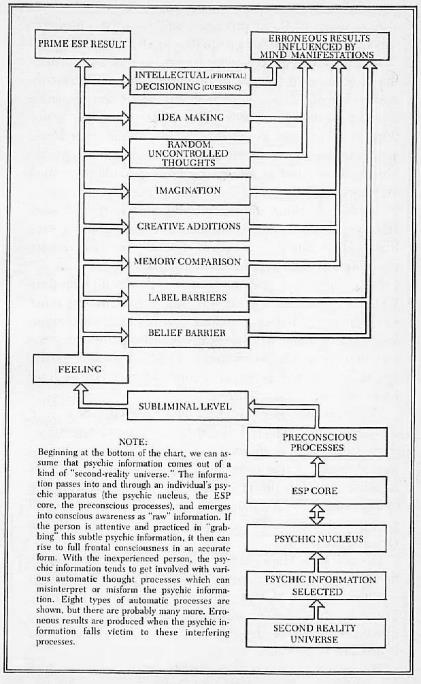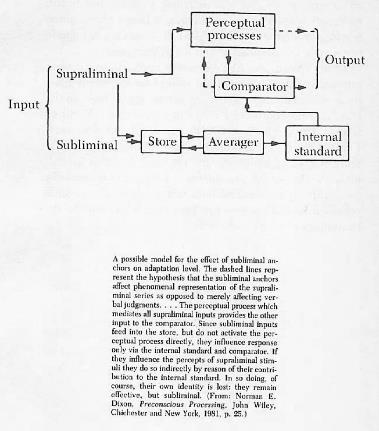
The Self-Generating Processes of the ESP Core
This book presents ESP as a natural talent. Like all the natural talents, it draws upon all the elements of the mind, including the brain. It transcends the limits of all these separate parts, and so is very hard to place in only one part, or even in a part of its own.
The easiest way to understand this, is to contact your own ESP core. In so doing, much of the argument about where ESP belongs quickly becomes academic.
The first step is to try a few ESP experiments that will convince you that you can get information about a target hidden from your sight.
You will probably be able to discriminate between your conscious efforts to “get” the information, and the information that “arrives” spontaneously in its correct or near-correct form. No amount of conscious concentration on the target will get this kind of information for you. After a dozen or more experiments, you will begin, with the help of this book, to become aware of the several phenomena closely associated with the processes through which you get the correct information. When you do get the target correctly, you will probably be able to see the information has arrived already processed, without any noticeable “help” from your frontal consciousness.
The term currently used to describe this “already processed” kind of phenomenon is “preconscious processing.” Scientists are now beginning to understand that much of human awareness derives from preconscious processes that are hidden from the light of waking, conscious thought, and control. Core ESP clearly operates in this hidden atmosphere, and in this sense, again is comparable to other human talents.
To simplify it, I’ve created the following illustration, which contains the fundamentals of the ESP process as I conceive them.
There are two aspects to awareness: the conscious processes and the preconscious processes, which normally operate in nonconscious areas of the mind. Between the nonconscious and consciousness lies a band referred to as the subliminal threshold, through which incoming preconsciously processed information emerges into consciousness. Typically, the conscious mind analyzes the incoming information and tries to give it a consciously recognized structure.
If we think about this—and the fact that the ESP core can accurately construct and process psychic information—then we can understand that any impedance we may encounter, which degrades the clarity of the psychic information, comes from erroneous conscious misinterpretations of the psychic information, the misinterpretation being automatically superimposed over the true information.
Thus, we can begin to see that ESP information can be processed along at least two routes: through an unimpeded route, and through a route that passes through conscious idea generation. The two graphics below illustrate these two routes.



The unimpeded route shows that the psychic information probably entered the mind system through some of its unconscious and unknown spectra. It passed through the preconscious processing area, where it took on form, and then was projected upward into consciousness, where it was perceived in a correct output.
The idea-forming route shows that the information was rerouted through a conscious idea generation component of the mind. When it goes through this route, the mind adds interpretations which are frequently incorrect.
With these routes in mind, we can quickly add another step in the overall processes which must be present in both these routes—creativity. The incoming psychic information, traveling through its preconscious processing area, where it probably gathers its general form, also must pass through a creativity process that allows the individual to participate with it in a creative sense.
It is probably at this level of interaction that the psychic information acquires a good deal of its “noise.” The creativity channels are closely connected to a multitude of analytical thought processes, the emotions of the individual, and the visionary elements of his or her dreams, preoccupations, and education. If the psychic information pops up through these multifarious channels, it is easy to see how it can become impeded with other random mind elements. The following graphic shows some of the possible routes through which the psychic information can be conveyed before it reaches its final output.
I think that almost anyone who has done even a little creative work will agree that creativity and preconscious processing are very closely related. Both creative ideas and prime correct ESP information arrive out of a nebulous territory. It also seems clear that ESP is very closely associated with creativity and preconscious processing. Only a good grasp of these processes will be what ultimately aids the neophyte who wants to develop his own ESP core.

To a large extent, creativity is self-generated in areas of the mind beyond or beneath the individual’s willful, conscious control. All he can do is discipline his consciousness to accommodate the needs of the creative process. Since they seem to bear much in common at the core level, creativity, talents, and extrasensory perception are probably closely related as internal, subjective, self-generating activities beneath the level of consciousness.
If one’s conscious, objective, self-willed responses work at cross-purposes, the result will be either stasis or conflict, and the impulses of talent, creativity, or extrasensory perception will be repressed or stunted.
Once the self-generated internal needs of self-generating ESP are contacted and understood, conscious ingenuity can help design better conscious environments for them in the mind. In other words, creativity, talent, and extrasensory perception can be assisted and built upon consciously, but only after the essential natural internal factors have become clear to consciousness.
The examples given in this book, showing how ESP information is delivered through the mental apparatus, demonstrate a close affinity to new models of consciousness-unconsciousness that have been arrived at by researchers in other fields. A prime example of this comes from the work done by Dr. Norman Dixon in the field of subliminal perception. One of Dixon’s simpler charts is given here for comparison.
Dixon’s work shows that subliminal information enters first into a nonconscious memory store, is processed through an averager and then to internal standards, which are probably part of the individual’s nonconscious creative processes. Each of these areas involves a preconscious process of some kind.

The result of these unconscious processes rises into consciousness, where it is compared to conscious perceptual materials. Normally the output will be an amalgam of all these. But psychic information, to be unimpeded, cannot become such an amalgam. We need to consider this when we can see that ESP is trying to work, but is also malfunctioning. The malfunctioning is taking place in one or more of these areas, each of which is serving to impede or degrade the accuracy of the ESP information.
To my knowledge, ESP has never been addressed as an internal self-creating attribute whose natural needs must be ascertained, and which must not be approached on the basis of a predetermined series of expectations. I will go farther: The cultivation of ESP is an artistic performance. For every art, an appropriate craft is designed, and as more is learned about the art, the craft develops accordingly. A study of the phenomena arising out of natural raw core ESP, as exemplified both in the historical examples provided in this book and in your own work, will be the beginnings of such a new craft.